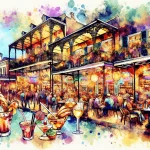Algiers Point, situated on the west bank of the Mississippi River, stands as a testament to New Orleans’ rich history and cultural heritage. As the city’s second-oldest neighborhood, Algiers Point has played a significant role in shaping the unique character of New Orleans.
In This Article
TL;DR
- Algiers Point, established in 1819, is one of New Orleans’ oldest neighborhoods, with a rich history tied to shipbuilding and riverfront industries.
- The neighborhood showcases a variety of architectural styles, including Greek Revival, Italianate, and Victorian homes, as well as notable historic buildings.
- Algiers Point is celebrated for its strong sense of community, vibrant cultural events, and thriving local economy, attracting both residents and visitors.
Historical Background of Algiers Point
The story of Algiers Point begins in 1819 when Andre Seguin established a boatyard in the area. The Algiers-Canal Street Ferry, which began operation in 1827, has been a vital link between the neighborhood and the rest of New Orleans ever since.
Throughout the 19th century, Algiers Point flourished as a center for shipbuilding, repair, and other riverfront industries. The town of Algiers was officially annexed by the City of New Orleans in 1870, but it continued to develop as a largely independent community well into the 20th century.
Architectural Heritage
Algiers Point is renowned for its stunning architectural heritage, which reflects the neighborhood’s growth and development from the mid-19th to early 20th centuries. The district is dominated by buildings in the Greek Revival, Italianate, and Victorian styles, showcasing the area’s period of greatest prosperity from 1850 to 1900.
Following a devastating fire in 1895 that destroyed hundreds of buildings, many fine examples of early 20th-century architectural styles, such as Bungalow, Mission Revival, and Moderne, were constructed in Algiers Point.
Notable historic buildings in the neighborhood include:
The Vallette-Barrett House (1848)
A significant example of Greek Revival architecture.
Martin Behrman High School
An excellent example of the Mission Revival style and a local icon.
The Algy Theater and Phillip Foto’s Folly Theater
Two historic movie theaters that have been adaptively reused.
Efforts to preserve the architectural integrity of Algiers Point are ongoing, with local government and community groups working together to protect the neighborhood’s unique character.
Cultural Significance
Algiers Point has made significant cultural contributions to New Orleans, with its vibrant community events and strong artistic presence. The neighborhood hosts several annual festivals and events that highlight its rich heritage, such as:
Wednesdays at the Point
Weekly summer concerts featuring local musicians.
Algiers Friendship Day
A celebration of the neighborhood’s strong sense of community.
Mississippi River Fest
An event that showcases the importance of the river to Algiers Point’s history and culture.
The influence of music and the arts is evident throughout the community, with numerous local artists and musicians calling Algiers Point home.
Community and Lifestyle
Algiers Point is known for its close-knit community and small-town atmosphere, despite being part of the larger city of New Orleans. The neighborhood is home to a diverse population, including artists, professionals, and families who have lived in the area for generations.
Community organizations play a vital role in maintaining the strong sense of identity and connection among residents.
Daily life in Algiers Point revolves around its local businesses, parks, and community spaces. The neighborhood features numerous locally-owned restaurants, bars, and cafes, many of which host live music and events.
Residents enjoy spending time in the area’s green spaces, such as Larkin Park, Delcazal Park, and Confetti Park, as well as along the levee, which offers stunning views of downtown New Orleans.
Economic Impact
Algiers Point plays a significant role in the local economy of New Orleans, with its historic charm and convenient location attracting both residents and visitors. The neighborhood’s proximity to downtown New Orleans, accessible via the Algiers-Canal Street Ferry, makes it an attractive option for professionals working in the city.
Tourism is a key driver of the local economy, with visitors drawn to Algiers Point’s unique architecture, cultural events, and scenic views. The neighborhood’s locally-owned businesses, including restaurants, bars, and shops, benefit from the influx of tourists seeking an authentic New Orleans experience.
Modern Developments
While Algiers Point cherishes its historical roots, the neighborhood has also experienced recent developments and changes. The community faces challenges such as maintaining its unique character in the face of modernization and ensuring that new developments align with the neighborhood’s architectural and cultural heritage.
However, these challenges also present opportunities for growth and revitalization. Planned projects in Algiers Point aim to enhance the neighborhood’s amenities and infrastructure while preserving its historic charm. The future of Algiers Point looks bright, with a strong commitment from residents and local organizations to maintain the community’s unique identity and character.
Preservation Efforts
Preserving the historical and cultural heritage of Algiers Point is a top priority for the community. Local government and community groups work together to protect the neighborhood’s architectural integrity and promote its rich history.
Initiatives such as the Algiers Point National Historic District and the city-regulated Algiers Point Historic District ensure that new developments and renovations adhere to guidelines that maintain the area’s unique character. These efforts have led to numerous success stories of preservation and revitalization throughout the neighborhood.
By celebrating its past and embracing its future, Algiers Point continues to thrive as a beloved community within the larger landscape of New Orleans. Its enduring legacy serves as a reminder of the city’s rich history and the importance of preserving its cultural heritage for generations to come.






